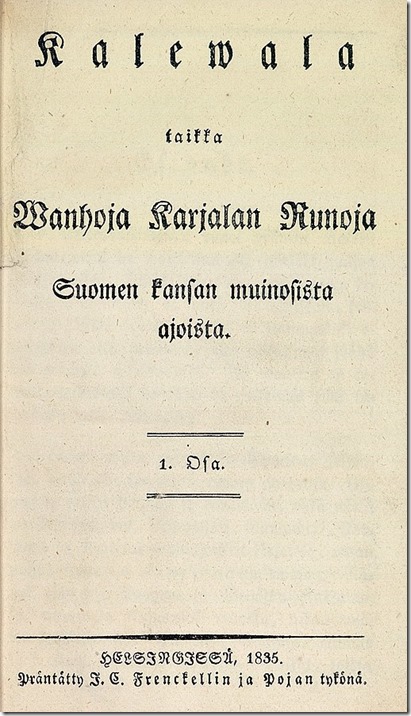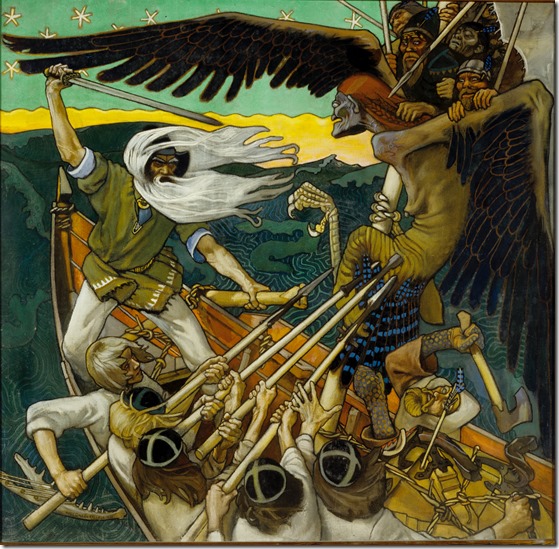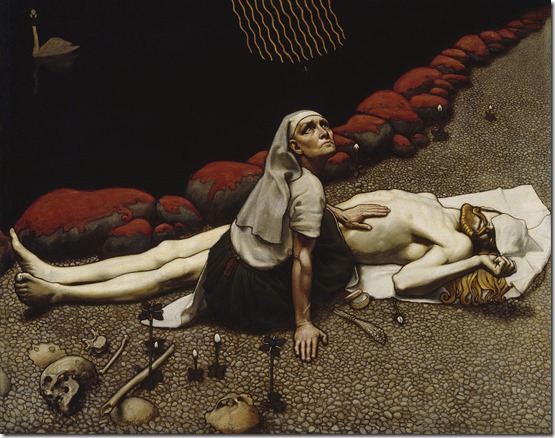From Wikipedia, the free encyclopedia
For other uses, see Kalevala (disambiguation).
|
Kalevala |
|
|
Kalevala. The Finnish national epic by Elias Lönnrot. First edition, 1835. |
|
|
Author |
|
|
Original title |
Kalevala (or Kalewala, first edition, 1835) |
|
Translator |
|
|
Country |
|
|
Language |
|
|
Genre |
|
|
Publisher |
J. C. Frenckell ja Poika, among others |
|
Publication date |
|
|
Published in English |
|
|
Pages |
|
|
894.5411 |
|
|
PH324 .E5 |
|
|
Original text |
Kalevala (or Kalewala, first edition, 1835) at Finnish Wikisource |
|
Translation |
Kalevala at Wikisource |
The Kalevala (Finnish: Kalevala, IPA: [ˈkɑleʋɑlɑ]) is a 19th-century work of epic poetry compiled by Elias Lönnrot from Karelian and Finnish oral folklore and mythology,[1] telling an epic story about the Creation of the Earth, describing the controversies and retaliatory voyages between the peoples of the land of Kalevala called Väinölä and the land of Pohjola and their various protagonists and antagonists, as well as the construction and robbery of the epic mythical wealth-making machine Sampo.[2]
The Kalevala is regarded as the national epic of Karelia and Finland[Note 1] and is one of the most significant works of Finnish literature with J. L. Runeberg’s The Tales of Ensign Stål and Aleksis Kivi’s The Seven Brothers.[4][5][6] The Kalevala was instrumental in the development of the Finnish national identity and the intensification of Finland’s language strife that ultimately led to Finland’s independence from Russia in 1917.[7][8] The work is also well known internationally and has partly influenced, for example, J. R. R. Tolkien’s legendarium (i.e. Middle-earth mythology).[9][10]
The first version of the Kalevala, called the Old Kalevala, was published in 1835, consisting of 12,078 verses. The version most commonly known today was first published in 1849 and consists of 22,795 verses, divided into fifty folk stories (Finnish: runot).[11] An abridged version, containing all fifty poems but just 9732 verses, was published in 1862.[12] In connection with the Kalevala, there is another much more lyrical collection of poems, also compiled by Lönnrot, called Kanteletar from 1840, which is mostly seen as a ”sister collection” of the Kalevala.[13]
”Kalevala melody” in old Finnish and English – Tania sings
Loituma –Missing Him trasnaltion Susan Sinisalo
Kun Mun Kultani Tulisi/Missing Him by Loituma off their 1998 album Things of Beauty. ”A love song from the Kanteletar published in 1802 already in French, English, German and Dutch. Goethe later made it famous under the name of ”Finnisches Lied”. In the middle of the 19th century a Swede by the name of C.G. Zetterqvist collected 467 translations of the poem in different languages, but they were never published.”
Tolkien and the Kalevala
Akseli Gallen-Kallela
From Wikipedia, the free encyclopedia
Akseli Gallen-Kallela (26 April 1865 – 7 March 1931) was a Finnish painter who is best known for his illustrations of the Kalevala, the Finnish national epic. His work is considered a very important aspect of the Finnish national identity. He changed his name from Gallén to Gallen-Kallela in 1907.[1]
The Defense of the Sampo (1896). Tempera on canvas, 125 × 122 cm (49.2 × 48 in). Turku Art Museum by Akseli Gallen-Kallela
The Mother of Lemminkainen by Akseli Gallen-Kallela
Please enlarge the drawings by clicking on them with the mouse cursor.
Jean Sibelius
From Simple English Wikipedia, the free encyclopedia
Jean Sibelius (born Hämeenlinna (Tavastehus) 8 December 1865; died Järvenpää, 20 September 1957) was a Finnish composer. He is one of the most famous people from Finland and one of the greatest composers of symphonies of all time. He was born at a time when Russia had a lot of power in Finland and the Finnish people were trying hard to keep their own culture and their independence. This nationalism can be heard in a lot of his music, especially some of the choral music. After 1928 he composed very little. He lived in retirement in his home in the Finnish countryside
Lemminkäinen Suite
The Kalevala: the Epic Poem of Finland (Crawford Translation) by Elias LÖNNROT Part 1/3
The Project Gutenberg eBook of Kalevala: the Epic Poem of Finland, by Elias Lönnrot
This eBook is for the use of anyone anywhere in the United States and most other parts of the world at no cost and with almost no restrictions whatsoever. You may copy it, give it away or re-use it under the terms of the Project Gutenberg License included with this eBook or online at www.gutenberg.org. If you are not located in the United States, you will have to check the laws of the country where you are located before using this eBook.




